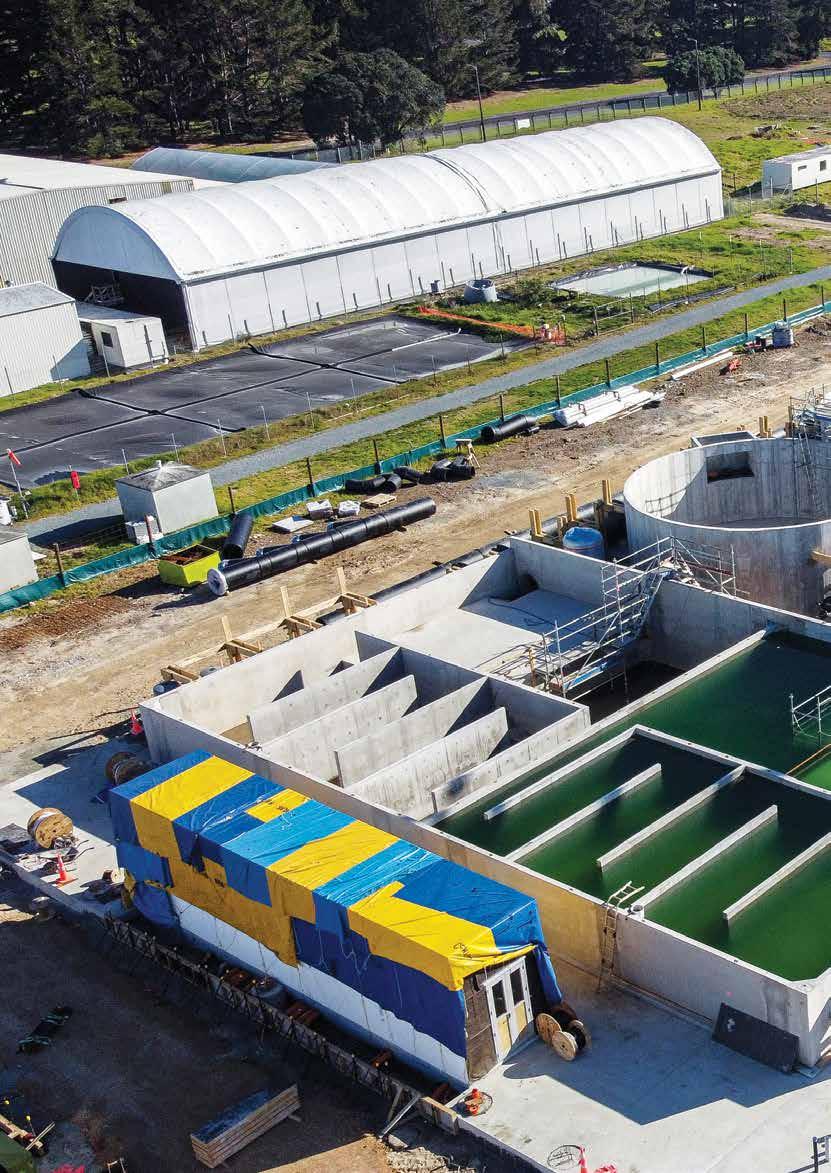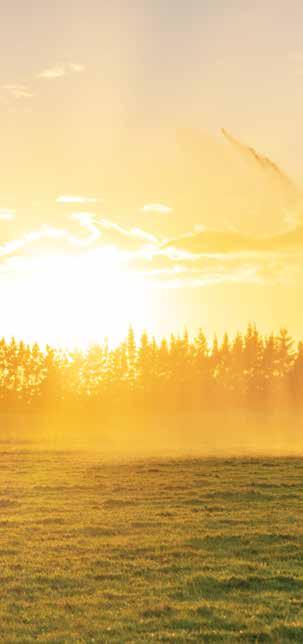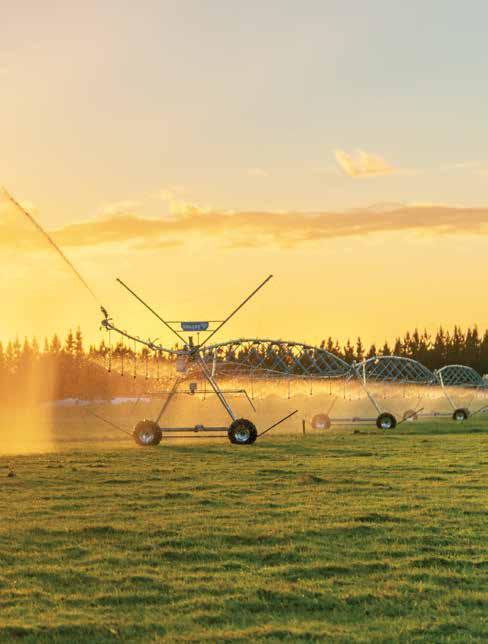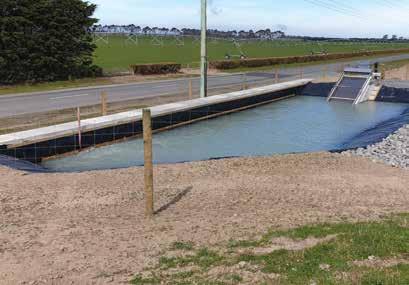
5 minute read
Providing industry opportunities
by NIWA_NZ

ADVANCING SUSTAINABILITY
Advertisement
• High-resolution environmental forecasting • Climate projections to inform land use • New tools to monitor fish populations and ecosystems
GROWING REGIONAL ECONOMIES
• Forecasting for weather-sensitive industries • Climate projections for regional planning • Forecasting to improve tourism operations
DIVERSIFYING AQUACULTURE • Recirculating Aquaculture Systems (RAS) • Commercial-scale trials of kingfish • Improved mussel and oyster productivity
ALLOCATING WATER BETTER
• Effect of climate change on water use • Flow forecasting • Tools to increase water-use efficiency

Sustainable land-based aquaculture creating premium kingfish
Land-based aquaculture can have significant economic, environmental and social benefits for New Zealand, and construction of the nation’s first commercial-scale recirculating aquaculture system (RAS) is well advanced to demonstrate this at NIWA’s Northland Aquaculture Centre in Bream Bay. Land-based aquaculture using RAS has significant advantages – it offers total control over the stock, much higher feed conversion rates and a significantly smaller environmental footprint. The construction of eight 350,000-litre fish tanks with two independent water treatment plants is due for completion and expected to be operational in early 2023. When operating at full capacity, the unit will demonstrate the practical use of this technology for the commercial, whole-of-cycle production of premium kingfish, and it will sustainably produce about 600 tonnes of kingfish every year. Our kingfish – called Haku (kingfish in Te Reo Māori) – are already served at more than 65 top class restaurants across the country, where they are prized for their high quality, rich creaminess, superior texture and sweet flavour.
Our kingfish are harvested at 12 months, when they weigh 3–4 kgs. [Stuart Mackay]




The pipe intake on the Acton Irrigation Scheme. Water from the small pond then runs through a filter and into the piped delivery system. [Rod Mckay] NIWA has provided innovative flow monitoring and control systems and operational support to irrigation schemes for more than 20 years. [Stuart Mackay]
Increasing irrigation water-use efficiency
As fresh water becomes increasingly scarce, its usage comes under greater scrutiny. For high-use irrigation, water-use efficiency is key. NIWA has been working with large irrigation schemes around the Canterbury region for more than two decades, and the Acton Irrigation Scheme near Rakaia has been the focus of some recent water-use efficiency work. The scheme is working to replace leaky, open-channel distribution races with a piped system, and NIWA has been integrating the monitoring and control of the new piped delivery system with the intake and storage systems. This will allow the system to reduce – ideally eliminate – water losses, and therefore provide more efficient use of water taken from the river source. The new controls that manage the delivery of water to on-farm ponds allow the farms to take water when it’s available and then store it. This can then be saved for when it is needed, and it provides more surety of supply and a more efficient use of water than previously, when it was ‘use it when you can, just in case’. That scenario caused wastage and overwatering. The water delivery system has been further enhanced by the addition of on-farm pond level monitoring. This enhances the scheme’s ability to assess the need for water and the capacity available.
Using robots to count fish
NIWA fisheries scientists have been testing innovative technologies to help them count fish. They have been working with New Zealand drone company X-Craft who developed Nemesis, a 6-metre autonomous vessel equipped with artificial intelligence software and data-gathering equipment which includes a batterypowered echosounder to estimate the size of fish populations. The vessel performed well in its first deepwater test run in Cook Strait in February, coping with the strong tides. The next steps are to carry out trials in the Hauraki Gulf using the echosounder to look for small pelagic fish, as well as potentially adding a passive acoustic device to listen for whales at the same time. This type of technology could complement the work being done on larger vessels, because it can operate over a wider area or time, collecting quality acoustic data in depths up to 600 metres. The vessel can be programmed to follow a specific track and is equipped with anti-collision technology. Scientists hope to be routinely using this type of vessel for monitoring fish within the next five years, leading to improved estimates of abundance, with the ultimate outcome of better management of our fish populations.
NIWA is improving the way it collects information on fisheries by using alternative survey platforms such as Nemesis, an autonomous surface vessel equipped with echosounding technology. The vessel is quiet, cost-effective and can cover areas not surveyed by large research or fishing vessels. [Lana Young]

Greenshell mussels [Darryl Torckler]

The webtool may also be useful for fish farmers and other sectors because it shows current ocean temperatures around New Zealand, where the seas are warmer or cooler than normal and where marine heat waves might be. [NIWA]
Weather forecasting helping mussel forecasting
A collaboration between mussel experts, climate scientists and data scientists has produced a publicly available webtool that can help forecast mussel yields. Designed predominantly for New Zealand’s largest greenshell mussel industry area – the Pelorus Sounds – the tool uses climate data, especially sea surface temperatures, and historical mussel yield information to predict mussel growth, quality and yields for the coming season. The new tool draws on historical mussel ‘crop’ performance, and uses advanced data modelling methods, more reliable seasonalscale weather forecasts and better remote sensing data. Drawing these factors together will help forecast mussel condition in the upcoming season. This in turn aids decision making in the industry – a better understanding of mussel quality will improve business projections.











